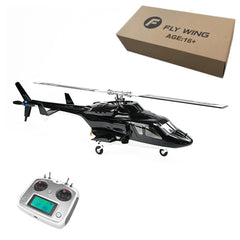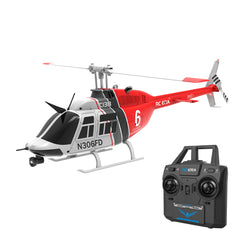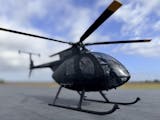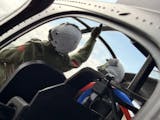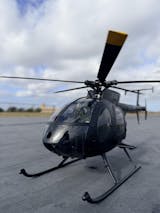Why Stabilization Systems Matter in RC Helicopters
- Minimized Drift: Keeps the helicopter in place even in light wind.
- Improved Flight Safety: Reduces crash risk for beginners by correcting sudden movements.
- Enhanced Video Quality: Provides smoother footage for aerial photography.
GPS Stabilization System in RC Helicopters
How It Works
Key Features
- Position Hold (Loiter Mode): Locks the heli in place, even in variable winds.
- Return-to-Home (RTH): Brings the helicopter back to its takeoff point with a single command or when the signal is lost.
- Waypoint Navigation: Allows pre-programmed flight paths, useful for aerial mapping and surveying.
Pros and Cons
- Reliable outdoor stability in varying conditions.
- Safe for long-range flying.
- Essential for precision mapping and GPS-assisted photography.
- Ineffective indoors or under heavy obstruction (e.g., dense urban areas, thick trees).
- Requires time for GPS lock before flight.
Best Use Cases
- Outdoor recreational flying in open spaces.
- Professional aerial photography and videography.
- Surveying and mapping projects.

Optical Flow Positioning in RC Helicopters
How It Works
Advantages
- Works indoors and in GPS-denied environments.
- Offers pinpoint accuracy at low altitudes (typically below 5-10 meters, varying by model and lighting).
- Complements GPS for hybrid stabilization in outdoor flights.
Limitations
- Requires good lighting and visible ground patterns.
- Performance decreases over uniform or reflective surfaces—struggles on water or plain snow.
- Ineffective at higher altitudes due to reduced ground detail visibility.
Best Use Cases
- Indoor hovering practice.
- Urban flying where GPS falters.
- Smooth, low-altitude video capture.

Other Key Stabilization Systems in RC Helicopters
Gyroscope (Gyro System)
- Single-axis gyro: Stabilizes yaw (tail rotor control) to prevent unwanted rotation.
- 3-axis gyro(3G): Controls yaw, pitch, and roll for comprehensive attitude stability.
- 6-axis gyro(6G): Combines a 3-axis gyro with accelerometers to maintain level flight automatically.
Benefit: Fast response to movement; works in both indoor and outdoor environments.
Limitation: Handles orientation, but not position—drift persists without add-ons.
Inertial Measurement Unit (IMU)
- Combines a gyroscope and an accelerometer, and sometimes a magnetometer for heading data.
- Provides real-time attitude sensing, essential for advanced flight controllers.
- Works even without GPS, but benefits from integration with other systems for positional stability.
Barometer (Altitude Hold)
- Detects air pressure changes to maintain a set altitude.
- Reduces pilot workload during hovering and aerial shooting.
- Can be affected by rapid temperature or weather changes.
Compass (Magnetometer)
- Functions as a digital compass to maintain heading.
- Often used with GPS for more accurate navigation and orientation hold.
How These Systems Work Together
- GPS + Optical Flow: GPS handles outdoor position locking, while optical flow takes over indoors or in GPS-denied areas. This dual setup ensures continuous stability across environments.
- Gyro + Barometer: Gyro stabilizes attitude (yaw, pitch, roll), and the barometer maintains consistent altitude. Together, they make hovering much smoother.
- IMU Integration: The IMU fuses data from the gyro, accelerometer, and magnetometer to create a precise attitude reference. When combined with GPS or optical flow, it ensures both position and orientation stability.
Choosing the Right Stabilization System for Your RC Helicopter
| Pilot Type | Recommended Systems | Why It Works |
| Beginner | GPS + 6-axis Gyro | Position hold outdoors + automatic level correction for learning. |
| Indoor Flyer | Optical Flow + Gyro | Reliable hovering in small spaces without GPS. |
| Outdoor Recreational | GPS + IMU + Barometer | Stable outdoor flights with altitude hold and orientation accuracy. |
| Aerial Photographer | GPS + Optical Flow + Compass | Smooth, precise hovering for high-quality footage in varied environments. |
| Advanced/Professional | GPS + Optical Flow + IMU + Obstacle Avoidance | Maximum stability, safety, and automation for complex projects. |
Maintenance & Calibration Tips
- Gyro and IMU Calibration
- Perform calibration on a level surface before each flight session.
- Avoid metal surfaces or strong magnetic fields during calibration.
- GPS Module Care
- Ensure the antenna has a clear view of the sky for faster satellite lock.
- Keep firmware updated to improve positioning accuracy.
- Optical Flow Sensor Maintenance
- Clean the camera lens regularly to prevent dust from affecting accuracy.
- Avoid flying over reflective or uniform surfaces where pattern detection fails.
- Barometer & Compass Checks
- Avoid sudden temperature changes before flight to keep barometer readings accurate.
- Recalibrate the compass if you notice drifting in heading.
- Firmware & Software Updates
- Regular updates often improve sensor fusion algorithms and stability performance.



